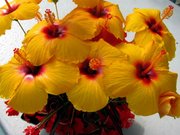By Gardener Jack
The hibiscus is one of the easiest of all flowers to identify. The flat-lying five petals and outstanding staminal column are readily recognisable and a string of them in the form of a lei is placed around your neck by a local lovely when you visit Hawaii.
The regular large-flowered hibiscus we are used to seeing on a daily basis comes to us from China and is a coastal plant. If a healthy plant is pruned judiciously over the years it can become a large tree- like shrub.
Hibiscus is in the family Malvaceae that includes marsh mallow (Althaea officinalis). Mucilagenous sap was obtained from the roots of marsh mallow and combined with honey and rose water to form a distinctive confection - marshmallow. Modern marshmallows are made from gelatin, sugar and corn starch.
The mahoe (Hibiscus tiliaceae) grows into a large tree naturally. In the wild, near the sea, it can grow to a vast size without any interference from man. The yellow flowers tend to turn dark red in the afternoon. I once read a detective story where a murderer's alibi was undermined when it was pointed out that the mahoe flowers in a photograph were red and not yellow. At which point, of course, the murderer broke down and conveniently confessed. Mahoes are often used as plantings alongside highways in The Bahamas.
One hibiscus that is fun to plant is H. cannabinus. Visitors to your garden who are not familiar with the plant will automatically assume you are growing illegal wacky weed because the leaves very closely resemble those of marijuana. The plant was once raised commercially in Asia for its very tough fibres, used to make rope.
The flower of Turk's cap never opens fully and that habit leads to the common name 'Scotchman's Purse'. Turk's cap hibiscus (Mallvaviscus peduliflorus or M. arboreus) is a very tough plant that needs little care. The flowers are usually bright red but I once came across a stunning pink version.
One type of Turk's cap grows wild in The Bahamas and is called Bahama Hibiscus (M. brittonianus). It can be found in coppice land near to the sea and I observe it regularly on the coastal mainland of Abaco and the Abaco cays.
An interesting and useful hibiscus is H. sabdariffa, commonly known as roselle. It is a biennial but tends to grow as an annual in The Bahamas. The enlarged calyxes can be boiled to produce rosella jam, a delicious jelly with a beautiful colour.
One of the more unusual hibiscus varieties is Rose of Sharon (H. syriacus) or althaea. The petals have a lavender blue colouration that is strikingly different from the reds, pinks, yellows and oranges we are used to. Unfortunately, Rose of Sharon is not a tropical plant and cannot take our summer heat. Planted in early autumn, a flowering Rose of Sharon will do well in our cool season weather but die off in early summer.
The Rose Mallow is another hibiscus that is unsuited for tropical summers but will survive the cooler months. The flowers are vast, the size of a small dinner plate, and quite spectacular.
One hibiscus that is often found in vegetables gardens, especially this time of year, is H. esculentus or okra. The bright yellow flowers are of typical hibiscus design while the enlarged calyx becomes gumbo or okra - beloved by some, hated by others.
One of my favourite hibiscus varieties is H. schizopetalus, or Japanese Lantern. The staminal column is long and pendulous and hangs down below a feathery mass of deeply divided petals. The slightest breeze will cause the flower to 'dance'.
gardenerjack@coralwave.com





Comments
Use the comment form below to begin a discussion about this content.
Sign in to comment
Or login with:
OpenID